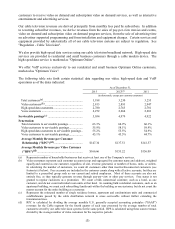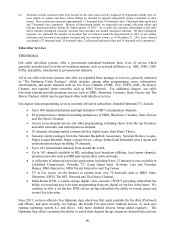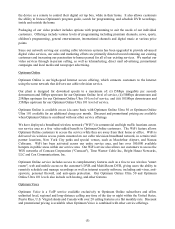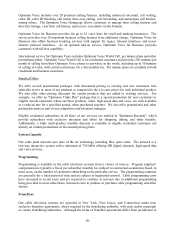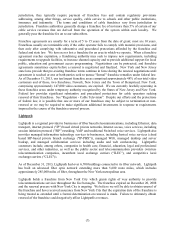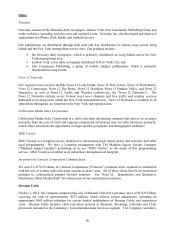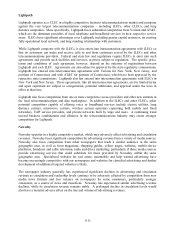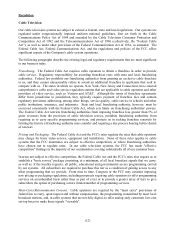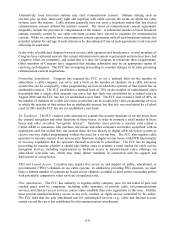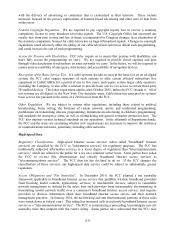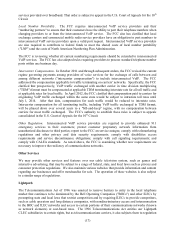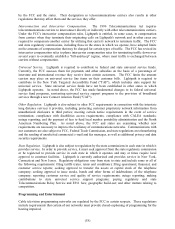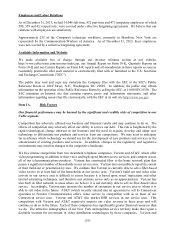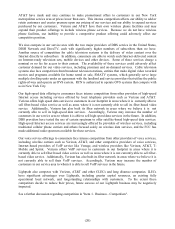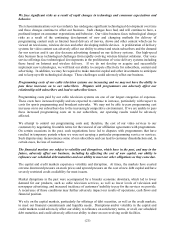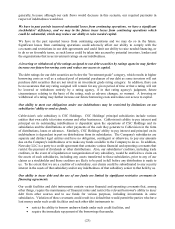Cablevision 2013 Annual Report Download - page 19
Download and view the complete annual report
Please find page 19 of the 2013 Cablevision annual report below. You can navigate through the pages in the report by either clicking on the pages listed below, or by using the keyword search tool below to find specific information within the annual report.(13)
Alternatively, local television stations may elect retransmission consent. Stations making such an
election give up their must-carry right and negotiate with cable systems the terms on which the cable
systems carry the stations. Cable systems generally may not carry a broadcast station that has elected
retransmission consent without the station's consent. The terms of retransmission consent agreements
frequently include the payment of compensation to the station. A substantial number of local broadcast
stations currently carried by our cable television systems have elected to negotiate for retransmission
consent. While we currently have retransmission consent agreements with all such broadcast stations, the
potential remains for carriage of such stations to be discontinued if any of such agreements is not renewed
following its expiration.
In the wake of publicized disputes between several cable operators and broadcasters, several members of
Congress have expressed concern that current retransmission consent requirements and practices have had
a negative effect on consumers, and stated that it is time for Congress to reexamine those requirements.
Other members of Congress have suggested that binding arbitration may be an appropriate means of
resolving such disputes. The FCC has an ongoing proceeding to consider changes to its rules governing
retransmission consent negotiations.
Ownership Limitations. Congress has required the FCC to set a national limit on the number of
subscribers a cable company can serve, and a limit on the number of channels on a cable television
system that can be occupied by video programming services in which the operator of that system has an
attributable interest. The FCC established a national limit of 30% on the number of multichannel video
households that a single cable operator can serve, but that limit was invalidated by a federal court in
August 2009 and the FCC has not yet established a new limit. The FCC also created a limit of 40% on
the number of channels on a cable television system that can be occupied by video programming services
in which the operator of that system has an attributable interest, but that rule was invalidated by a federal
court in 2001 and the FCC has not yet established a new limit.
Set Top Boxes. The FCC requires cable operators to separate the security functions of set-top boxes from
the channel navigation and other functions of those boxes, in order to promote a retail market in these
boxes and other so-called "navigation devices". Operators must provide a security card (called a
CableCARD) to consumers who purchase televisions and other consumer electronics equipment with an
appropriate card slot so that they can connect those devices directly to digital cable television systems to
receive one-way digital programming without the need for a set-top box. The FCC also requires cable
operators to separate security from non-security functions in digital set-top boxes with DVR functionality
or two-way capabilities that the operators themselves provide to subscribers. The FCC has an ongoing
proceeding to examine whether it should take further steps to promote a retail market for cable service
navigation devices, including requirements to facilitate access to Internet-based video offerings via
subscribers' television sets, which may entail further mandates in connection with the support and
deployment of set top boxes.
PEG and Leased Access. Localities may require free access to, and support of, public, educational, or
governmental ("PEG") channels on our cable systems. In addition to providing PEG channels, we must
make a limited number of commercial leased access channels available to third parties (including parties
with potentially competitive video services) at regulated rates.
Pole Attachments. The FCC has authority to regulate utility company rates for the rental of pole and
conduit space used by companies, including cable operators, to provide cable, telecommunications
services, and Internet access services, unless states establish their own regulations in this area. Utilities
must provide nondiscriminatory access to any pole, conduit, or rights-of-way controlled by the utility.
The FCC held that the pole attachment rate for commingled services (e.g., cable and Internet access)
cannot exceed the rate it has established for telecommunications attachments.


